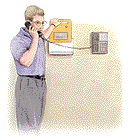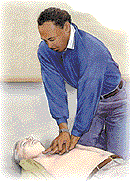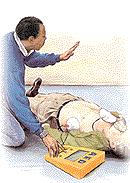Medical Advices
This
part is very important because it will deal with emergencies in simple way
Basic
Life support
Did
you face a situation that you are alone and there's somebody in need of help-May
be you will blame yourself if you can't do anything
Here a chance to something then you will be able to do something
Chain of survival
To deal
with a case of cardiac arrest this a multilevel procedure for
nonprofessionals and professionals people.
Cardiopulmonary resuscitation CPR or in a
simple way heart massage during arrest is not enough only to save lives in
most of cases .Its only part of chain the other parts are early access to
the victim by asking help as soon as possible .earl defibrillation & early
advanced care .The two items are only for specialized people. All these
items are called Chain of life
Technique of CPR
Airway opening
immediate opening of the airway by proper positioning of head remember that
tongue is the most common cause of airway obstruction in unconscious victim.
This can be done easily by head tilt and chin lift unless there is neck
injury only we can do jaw trust
Breathing
We
must determine breathing stat of the victim then we can start artificial
breathing . The easiest way to do this is mouth to mouth breathing . this
is to be continuous until victim can breath or trained professional arrived
Resuscitation
assessment of presence of pulse in neck - carotid- is very important step .
If there is no pulse you must start chest compression If you are
alone you must do 15 compression and 2 ventilations. At the end of 4
cycles check for return of
I got very nice gift for
you. A nice and useful share for our senior CPR instructor
Dr.
Amr Shams
|
Chain of Survival
The Links in the Chain of Survival
|
|
Early Access:
Call 997 (or the EMS system in your area) and get an AED!

|
Recognize an Emergency.
First, you or other witnesses must recognize the emergency. You must
recognize the warning signs of a heart attack, cardiac arrest, stroke,
or choking. Anyone who is unresponsive should receive emergency care.
Heart attack, cardiac arrest, stroke, and foreign-body airway
obstruction can each cause unresponsiveness. Although many conditions
— not just cardiac arrest — can cause unresponsiveness, all
unresponsive victims will benefit from activation of the Chain of
Survival.
Call 997 (or the EMS system in your area).
As soon as an emergency is recognized, call 997. When you or another
rescuer calls 997, let the dispatcher ask you questions. While the
dispatcher interviews you, he or she will enter the data on a
computer. The information you give will be relayed to a response team.
Answer in short, specific replies, giving only the requested
information. The dispatcher will probably ask:
"What is your emergency?" You might answer, "A
customer had sudden chest pain and has now collapsed."
"What's happening now?" "My friend is giving
cardiopulmonary resuscitation. We have an automated external
defibrillator."
"Where is the patient located?" "We are at the
Evergreen Company, here at 1234 Fifth Avenue NE, in the back hall."
"What number are you calling from?" "The number
is 698
At this point the dispatcher may give you
directions such as "Stay on the line until I tell you to hang up.
Rescuers are being sent to your location. Please meet them and direct
them to the scene."
Remember, though, if you are alone, you must
immediately begin performing CPR, the next link in the chain.
|
|
|
Early CPR:
"Pump
and Blow"

|
Begin
Cardiopulmonary Resuscitation (CPR).
CPR is the critical link that buys time between the first link
(call 911) and the third link (use the AED). The earlier you
give CPR to a person in cardiac or respiratory arrest, the
greater their chance of survival. CPR keeps oxygenated blood
flowing to the brain and heart until defibrillation or other
advanced care can restore normal heart action.
Dispatcher-Assisted CPR and
Defibrillation and Enhanced 911. In many areas of the
country emergency dispatchers are taught how to help callers
give emergency care. With help from the dispatcher, callers can
give CPR (and use an AED). The instructions are basic and
simple, but they will help the victim until EMS personnel
arrive. Remember, CPR needs to be started immediately!
Using a prepared list of instructions, the dispatcher can coach
you through the basic steps of CPR. At a worksite you will
usually have help.
Use this approach Repeat the dispatcher's instructions loudly
to the other rescuers and confirm that they are following that
step If the patient vomits or other complications arise, tell
the dispatcher. Do not expect that you will perform perfectly in
such a crisis
Be sure that rescuers follow each instruction, even if it takes
extra seconds Ensure rescuer safety at all times When EMS
personnel arrive at the victim's side, the dispatcher will tell
you that he or she is hanging up You hang up last
.
Find Out if Your
Community Has Enhanced 911 (or No .in your area.
In enhanced 911 a computer automatically confirms the caller's
address. Also ask if your 911 dispatchers are trained to offer
pre arrival instructions to rescuers. This means that they can
give instructions for immediate care based on the clinical
criteria of the emergency. If not, become a vocal advocate for
such services in your community. Enhanced 911 can save precious
seconds, minutes, and even lives.
|
|
|
Early Defibrillation:
Use the AED!

|
Use
the Automated External Defibrillator (AED) to Treat Ventricular
Fibrillation.
Most sudden cardiac arrest victims are in ventricular fibrillation
(VF). VF is an abnormal, chaotic heart rhythm that prevents the heart
from pumping blood. VF causes more cardiac arrests than any other
rhythm (about 80% to 90% of cases). You must defibrillate a victim
immediately to stop VF and allow a normal heart rhythm to resume. The
sooner you provide defibrillation with the AED, the better the
victim's chances of survival. If you provide defibrillation within the
first 5 minutes of a cardiac arrest, the odds are about 50% that you
can save the victim's life. But with each passing minute during a
cardiac arrest, the chance of successful resuscitation is reduced by
7% to 10%. After 10 minutes there is very little chance of successful
rescue.
Public Access Defibrillation.
The AHA promotes the most rapid possible defibrillation of victims of
cardiac arrest. To do this the AHA wants to place AEDs in the hands of
trained, nontraditional rescuers. These include police, security
guards, and family members of patients at high risk for cardiac
arrest. Public access defibrillation (PAD) programs place AEDs in
homes, police cars, worksites, and public gathering places, under the
supervision of licensed physicians. PAD rescuers must be trained in
CPR and the use of an AED. When AEDs are readily available, rescuers
can provide defibrillation within the first few minutes of
out-of-hospital cardiac arrest. This dramatically increases the
victim's chances of survival.
Public access defibrillation programs and AED manufacturers should
work with local EMS systems. Program authorities or manufacturers
should notify EMS directors of AEDs placed in homes, businesses, or
other public areas.
Heartsaver AED.
The AHA has developed the Heartsaver AED Course to support the public
access defibrillation movement and specific PAD programs. The course
is designed to help you learn how to give CPR and use an AED. These
skills are essential in caring for the victim of cardiac arrest.
|
Next
Home
Back |
![]()
![]()